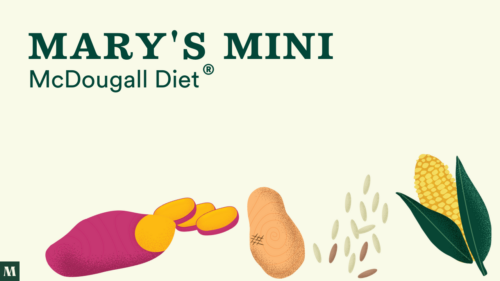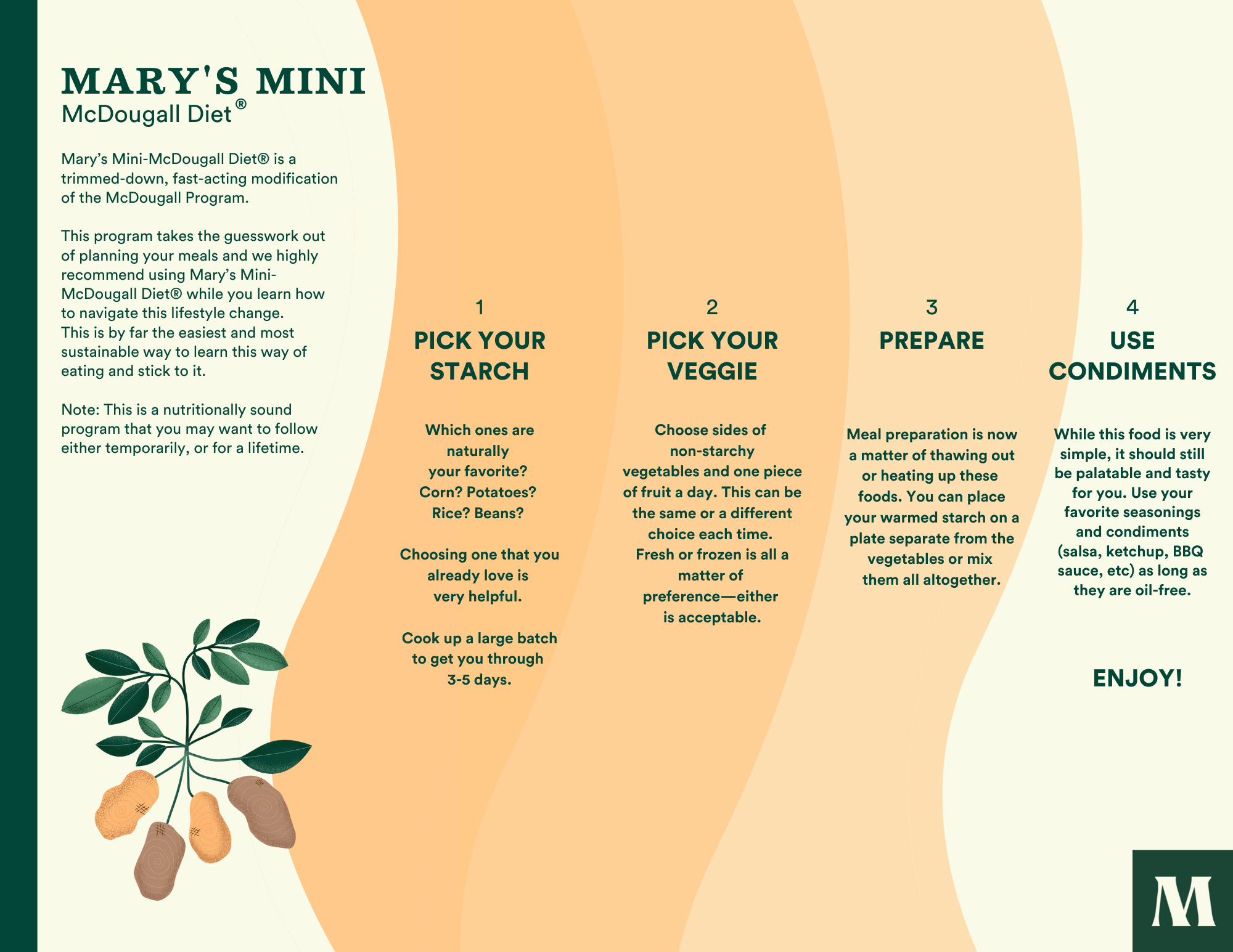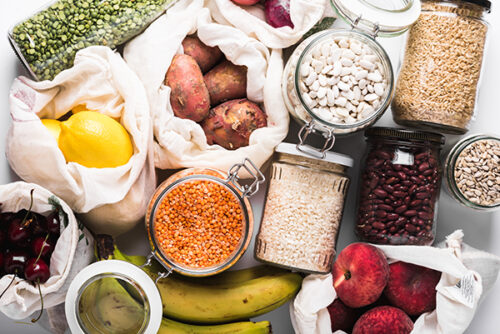Mary’s Mini-McDougall Diet® – An Overview

In the early 1980s, John and Mary went on an “all potato and greens” diet for 10 days—just for the experience. They ate hash browns for breakfast, baked potatoes and steamed frozen vegetables for lunch, and mashed potatoes with a salad for dinner. Yes, they were bored towards the end, but they each lost 10 pounds, felt great and continued their love for potatoes.
Mary’s Mini-McDougall Diet® is a trimmed-down, fast-acting modification of the regular McDougall diet: it is starch-based with the addition of non-starchy vegetables. This is a simplified tool for people overwhelmed by the initial challenges of starting on the McDougall program and/or boosting their progress when they feel that changes are coming too slowly. Mary’s Mini-McDougall Diet® is also used as a method for weight loss or a reset to get back on track with healthy eating.
Can anyone eat so simply?
You may be thinking “No one would follow such a simple eating program.” What if for reasons beyond your control, like political turmoil resulting in extreme poverty, you were forced to eat a simple diet? You would do so, rather than die!
Many populations living in such stark conditions, for example, people in rural areas of Poland and Russia at the beginning of the 19th century, have lived in very good health doing extremely hard work with the white potato serving as their primary source of nutrition. Their survival depended on potatoes. You could do the same if required, and the reality for millions of people living today is that their survival, too, depends upon a simple diet—but for the opposite kind of malnutrition than that of the Russians and Poles. Then the threat was undernutrition, and now it is overnutrition. Dying from heart disease, cancer and Type 2 diabetes is usually slower than starvation, but often more painful.
The truth is simple diets are among the most nutritious. Throughout history, almost all human inhabitants of Planet Earth have consumed simple diets. Eating basic foods is an especially powerful tool to regain lost health and appearance.
Examples of simple eating by trim healthy populations living today:
Japanese – rice
Peruvians – potatoes
Papua New Guinea Islanders – sweet potatoes
Rural Mexicans – corn
Each of these starches is combined with a few locally grown, seasonal vegetables.
B12 should be added as at least 5 micrograms daily after 3 years on any version of the McDougall Diet or if pregnant or nursing a baby while on the diet.
Will Mary’s Mini-McDougall Diet® Satisfy Me?
People naturally love the flavors found in starches, vegetables and fruits because we are anatomically and physiologically designed to consume and enjoy these foods. Remember, the taste buds on the tip of your tongue respond to carbohydrates (sweet) which are found almost exclusively in plant foods (the exceptions are milk and honey).
A landmark experiment was carried out in 1925 on two healthy adults, a man 25 years old and a woman 28 years old.2 For 6 months these two people lived on a diet primarily of white potatoes. (A few additional items providing insignificant nutrients were added: a few fruits, coffee and tea. Because they were losing too much weight, pure fat—containing no other nutrients—was also added.)
Could a diet of potatoes meet their nutritional needs? Even though they were both physically active (especially the man) they were described as, “…in good health on a diet in which the nitrogen (protein) was practically solely derived from the potato.”
Did they like this diet? The report stated, “They did not tire of the uniform potato diet and there was no craving for change.”
Starchy vegetables, like potatoes, are very appetite-satisfying. In an enlightening experiment, 38 separate foods were fed to subjects and a rating of their level of satisfaction (a satiety index) was determined every 15 minutes for 2 hours after the meals.3 The highest satisfaction level was produced by boiled white potatoes, and it was seven times higher than the lowest index for croissants. Potatoes were almost 5 times more satisfying than a Mars candy bar and twice as satisfying as beef or cheese. Starchy vegetables satisfy the hunger drive—fatty foods leave you craving.
You can adjust to simple eating, just like your pets are happy eating the same meal every day. You don’t worry if your dog and cat are enjoying their simple chow. They are hungry, the food satisfies them, and you know you are providing the best nutrition to keep them fit and long-lived.
Are Simple Diets Nutritious?
Most animals thrive on simple diets—the koala lives on eucalyptus leaves, the panda bear on bamboo shoots, the horse on grass, etc. The truth is that nature has designed her foods complete and balanced for proper nutrition, long before they reach your dinner table. You cannot improve on this blueprint.
White potatoes are 10% protein with all of the essential amino acids provided in generous amounts. These tubers have 2.5 grams of dietary fiber per potato. That translates into 50 grams for an active man and 37 grams for an active woman. Potatoes are very high in vitamin C, B vitamins, potassium and other minerals. In animal experiments, potatoes have been shown to have a particularly potent cholesterol-lowering effect.4
The potato even meets the needs of growing infants. Eleven Peruvian children, ages 8 months to 35 months, recovering from malnutrition, were fed diets where all of the protein and 75% of the calories came from potatoes.5,6 Their growth patterns were normal. (Soybean-cottonseed oils and pure simple sugars provided some of the extra calories—neither of these sources—oil or sugar—contains protein, vitamins or minerals.)
People in New Guinea who live on diets consisting almost entirely of sweet potato tubers and leaves have cholesterol levels, on average, of 108 mg/dL.7 Heart disease, obesity, inflammatory arthritis, colon cancer and type-2 diabetes are unknown in these people on their sweet potato diet.
Practical Application of Mary’s Mini-McDougall Diet®
Step 1: Choose one of several starches to form the centerpiece of your diet. Please note, the goal is to keep things monotonous, so you should only choose one starch. Which ones are naturally your favorite? Corn? Potatoes? Rice? Beans? Choosing one that you already love is very helpful. All of these can be found pre-cooked in packages in the frozen food section of your grocery store. Check the ingredients to make sure they are free of added fats, oils or other harmful ingredients. The refrigerated section of the store will also have packages vegetables for you to buy.* Cook up a large batch to get you through three to five days at a time.
Step 2: Once you have your basic cooked starches figured out, choose sides of non-starchy vegetables. This can be the same or a different choice each time. Fresh or frozen vegetables is all a matter of preference – either is acceptable.
*While root vegetables like potatoes and sweet potatoes provide well-rounded nutrition, grains and beans lack sufficient vitamins A and C when eaten alone; therefore, add some non-starchy vegetables to make your grain and bean meals complete.
Step 3: Prepare. Meal preparation is now a matter of thawing out or heating up these foods. You can place your warmed starch on a plate separate from the vegetables, or mix them all together.
Step 4: Use seasonings and condiments. While this food is very simple, it should still be palatable and enjoyable for you. Use your favorite seasonings and condiments (salsa, ketchup, packaged soups – like those made by Dr. McDougall’s Right Foods) – BBQ sauce, etc.) as long as they are oil-free.

Click here for a printable PDF of Mary’s Mini-McDougall Diet®.
Simple Eating-out Suggestions:
A baked potato or sweet potato with steamed vegetables like broccoli (steakhouse)
A plate of beans, lettuce, tomatoes and salsa (Mexican)
Steamed rice and vegetables (Chinese)
Steamed rice and green papaya salad (Thai)
Easing the Learning Curve
High protein diets are popular in part because they are easy to learn and follow: Buy a burger anywhere—throw away the bun, scrape off the ketchup and you are now on a diet that gives immediate weight loss. The working mechanism for this diet is to make you sick by feeding you an unbalanced diet solely of fat and protein, causing fluid loss and appetite suppression. Over the long course, this form of malnutrition causes your arteries to rot, your bones to be urinated into the toilet, your bowels to ache from plugged-up defecation and your body to smell like the stock-yards you pass while driving down highway 5 (from San Francisco to Los Angeles).
The learning curve for the McDougall Program can be steep: You must retrain your taste buds to enjoy unfamiliar foods, and you must also learn new ways to cook, shop and socialize. There are additional struggles: Healthy eating in restaurants may require additional requests with the wait staff and detective-like skills to locate McDougall-approved convenience items in the local grocery. Add to these burdens daily sabotage from well-meaning friends, family members and your own doctor. But, the reward from overcoming these obstacles is your best opportunity to have a lifetime of great health. Mary’s Mini-McDougall Diet® is a powerful tool to use for easing the learning curve and living with vitality.
Click here for common questions and answers to Mary’s Mini-McDougall Diet®.
If you’d like to learn more about how Mary’s Mini-McDougall Diet® can help you reach your goals, check out our Mary’s Mini-McDougall Diet® mini-course.
References:
1) J Pennington. Bowes & Church’s Food Values of Portions Commonly Used. 17th Ed. Lippincott. Philadelphia- New York. 1998.
2) Kon S. XXXV. The value of whole potato in human nutrition. Biochemical J. 1928; 22:258-260.
3) Holt S. A satiety index of common foods. Eur J Clin Nutr. 1995 Sep;49(9):675-90.
4) Morita T. Cholesterol-lowering effects of soybean, potato and rice proteins depend on their low methionine contents in rats fed a cholesterol-free purified diet. J Nutr. 1997 Mar;127(3):470-7.
5) Lopez de Romana G. Fasting and postprandial plasma free amino acids of infants and children consuming exclusively potato protein. J Nutr. 1981 Oct;111(10):1766-71.
6) Lopez de Romana G, Graham GC, Madrid S, MacLean WC Jr. Prolonged consumption of potato-based diets by infants and small children. J Nutr. 1981 Aug;111(8):1430-6.
7) Luyken R. Nutrition studies in New Guinea. Am J Clin Nutr. 1964; 14:13-27.
Recommended Articles

On Salad, Soup, and Success
![Who Needs to Take Statins? [What You Need to Know]](https://www.drmcdougall.com/wp-content/uploads/2023/02/Statins-500x333.jpeg)
Who Needs to Take Statins? [What You Need to Know]







